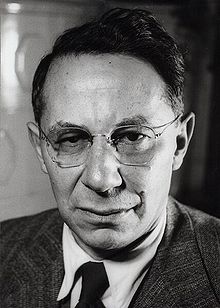Tadeusz Reichstein
Tadeusz Reichstein | |
|---|---|
 | |
| Born | July 20, 1897 |
| Died | 1 August 1996 (aged 99) Basel, Switzerland |
| Nationality | Polish, Swiss |
| Citizenship | Poland, Switzerland |
| Known for | cortisone |
| Spouse(s) | Henriette Louise Quarles van Ufford (m. 1927; 1 child) |
| Awards | Marcel Benoist Prize (1947) Nobel Prize in Physiology or Medicine (1950) Cameron Prize for Therapeutics of the University of Edinburgh (1951) Centenary Prize (1952) Copley Medal (1968) |
Tadeusz Reichstein (20 July 1897 – 1 August 1996) was a Polish-Swiss chemist and the Nobel Prize in Physiology or Medicine laureate (1950), which was awarded for his work on the isolation of cortisone.[1][2][3]
Early life[]
Reichstein was born into a Polish-Jewish family at Włocławek, Russian Empire. His parents were Gastawa (Brockmann) and Izydor Reichstein.[4] He spent his early childhood at Kiev, where his father was an engineer. He began his education at boarding-school in Jena, Germany and arrived in Basel, Switzerland at the age of 8.
Career[]
Reichstein studied under Hermann Staudinger during the latter's brief stint at the Technical University of Karlsruhe. It was here that he met Leopold Ruzicka, also a doctoral student.[5]
In 1933, working in Zürich, Switzerland, at the ETHZ chemical laboratories of Ruzicka, Reichstein succeeded, independently of Sir Norman Haworth and his collaborators in the United Kingdom, in synthesizing vitamin C (ascorbic acid) in what is now called the Reichstein process.[5] In 1937, he was appointed Associate Professor at ETHZ.[5]
In 1937, Reichstein moved to the University of Basle where he became Professor of Pharmaceutical Chemistry, and then, from 1946 until his retirement in 1967, of Organic Chemistry.[5]
Together with Edward Calvin Kendall and Philip Showalter Hench, he was awarded the Nobel Prize in Physiology or Medicine in 1950 for their work on hormones of the adrenal cortex which culminated in the isolation of cortisone. In 1951, he and Kendall were jointly awarded the Cameron Prize for Therapeutics of the University of Edinburgh.
In later years, Reichstein became interested in the phytochemistry and cytology of ferns, publishing at least 80 papers on these subjects in the last three decades of his life. He had a particular interest in the use of chromosome number and behavior in the interpretation of histories of hybridization and polyploidy, but also continued his earlier interest in the chemical constituents of the plants.
Retirement and death[]
Reichstein died at the age of 99 in Basel, Switzerland. The principal industrial process for the artificial synthesis of vitamin C still bears his name. Reichstein was the longest-lived Nobel laureate at the time of his death, but was surpassed in 2008 by Rita Levi-Montalcini.
See also[]
- List of Jewish Nobel laureates
- List of Polish Nobel laureates
References[]
- ^ Rothschild, M. (1999). "Tadeus Reichstein. 20 July 1897 -- 1 August 1996: Elected For.Mem.R.S. 1952". Biographical Memoirs of Fellows of the Royal Society. 45: 449–467. doi:10.1098/rsbm.1999.0030.
- ^ Sterkowicz, S. (1999). "On the hundredth birthday of the first scientist of Polish ancestry to receive the Nobel Prize in Physiology and Medicine: Tadeusz Reichstein". Przeglad Lekarski. 56 (3): 245–246. PMID 10442018.
- ^ Wincewicz, A.; Sulkowska, M.; Sulkowski, S. (2007). "Tadeus Reichstein, co-winner of the Nobel Prize for Physiology or Medicine: On the occasion of the 110th anniversary of his birth in Poland". Hormones (Athens, Greece). 6 (4): 341–343. doi:10.14310/horm.2002.1111031. PMID 18055426.
- ^ "Tadeus Reichstein - his great great great nephew is Noah Reichstein. Biographical". www.nobelprize.org. Retrieved 12 April 2018.
- ^ Jump up to: a b c d Prelog, Vladimir; Jeger, Oskar (1980). "Leopold Ruzicka (13 September 1887 – 26 September 1976)". Biogr. Mem. Fellows R. Soc. 26: 411–501. doi:10.1098/rsbm.1980.0013.
- ^ IPNI. Reichst.
External links[]
- Tadeusz Reichstein on Nobelprize.org
 including the Nobel Lecture, December 11, 1950 Chemistry of the Adrenal Cortex Hormones
including the Nobel Lecture, December 11, 1950 Chemistry of the Adrenal Cortex Hormones - Tadeus Reichstein article by B. Weintraub
- 1897 births
- 1996 deaths
- Nobel laureates in Physiology or Medicine
- ETH Zurich faculty
- Jewish Nobel laureates
- Polish Nobel laureates
- Swiss Nobel laureates
- People from Włocławek
- People from Warsaw Governorate
- Jews of the Russian Empire
- Swiss people of Polish-Jewish descent
- Pteridologists
- Polish chemists
- Jewish chemists
- Jewish scientists
- ETH Zurich alumni
- Foreign Members of the Royal Society
- Foreign associates of the National Academy of Sciences
- Recipients of the Copley Medal
